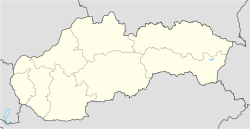Selice
Selice
Szelőce | |
|---|---|
village | |
 Church of Saint Michael | |
| Coordinates: 48°05′25″N 17°58′12″E / 48.09028°N 17.97000°E | |
| Country | Slovakia |
| Region | Nitra |
| District | Šaľa |
| First mentioned | 1078 |
| Government | |
| • Mayor | Igor Mandák |
| Area | |
| • Total | 38.35[2] km2 (14.81[2] sq mi) |
| Elevation | 113[3] m (371[3] ft) |
| Population (2021) | |
| • Total | 2,843[1] |
| Time zone | UTC+1 (CET) |
| • Summer (DST) | UTC+2 (CEST) |
| Postal code | 925 72[3] |
| Area code | +421 31[3] |
| Car plate | SA |
| Website | http://www.selice.eu/ |
Selice (Hungarian: Szelőce, formerly Sókszelőce; German: Seleuch) is a village and municipality in Šaľa District, in the Nitra Region of south-west Slovakia.
Geography[edit]
The village lies at an altitude of 113 metres and covers an area of 38.36 km2.
History[edit]
In historical records the village was first mentioned in 1078. In the 16th century, it was destroyed by Ottoman Turks. After the Habsburg monarchy collapse in November 1918, Czechoslovak troops occupied the area, later acknowledged internationally by the Treaty of Trianon. Between 1938 and 1945 Selice nad Dunajom once more became part of Miklós Horthy's Hungary through the First Vienna Award. From 1945 until the Velvet Divorce, it was part of Czechoslovakia. Since then it has been part of Slovakia. In 1946, the separate (and larger) village of Šók (Slovak; Sók or Magyarsók in Hungarian, Šóka in Romani) became part of Selice.
Population[edit]
According to the 2011 census, the municipality had 2,859 inhabitants. 1,416 of inhabitants were Hungarians, 1,241 Slovaks, 107 Roma, 18 Czechs and 77 others and unspecified.[5]
In a 2001 census, 59% (1682) of the inhabitants claimed Hungarian ethnicity, 36% (1011) Slovak ethnicity and 4% (108) Romani (Gypsy) ethnicity.[citation needed]
In a 1991 census, the numbers were 75% (2079), 21% (565) and 3% (83), respectively.[citation needed] The main reason behind the apparent decrease in the number of ethnic Hungarians is the fact that most Roma, who in fact represented 52% (1479) of the village population in 2005, claimed Slovak or Hungarian ethnicity.[citation needed] According to a 1968 census, there were 787 ‘citizens of Gypsy origin’ in Selice.[citation needed]
Facilities[edit]
The village has a public library and a gymnasium.
References[edit]
- ^ "Počet obyvateľov podľa pohlavia - obce (ročne)". www.statistics.sk (in Slovak). Statistical Office of the Slovak Republic. 2022-03-31. Retrieved 2022-03-31.
- ^ a b "Hustota obyvateľstva - obce [om7014rr_ukaz: Rozloha (Štvorcový meter)]". www.statistics.sk (in Slovak). Statistical Office of the Slovak Republic. 2022-03-31. Retrieved 2022-03-31.
- ^ a b c d "Základná charakteristika". www.statistics.sk (in Slovak). Statistical Office of the Slovak Republic. 2015-04-17. Retrieved 2022-03-31.
- ^ a b "Hustota obyvateľstva - obce". www.statistics.sk (in Slovak). Statistical Office of the Slovak Republic. 2022-03-31. Retrieved 2022-03-31.
- ^ "Obce Národnosť" (PDF). Archived from the original (PDF) on 14 November 2012.
External links[edit]
- Data as of 2005
- Selice Romani Vocabulary List (from the World Loanword Database)

